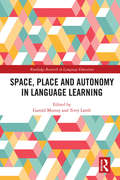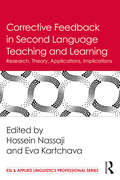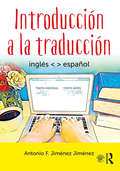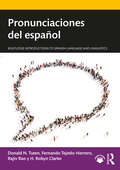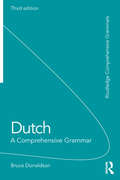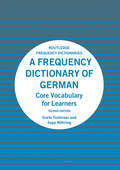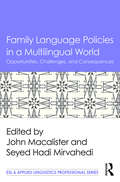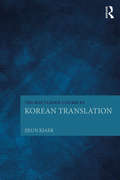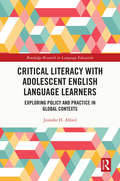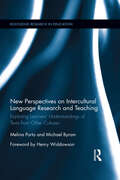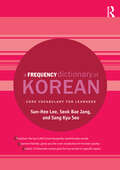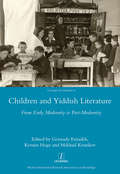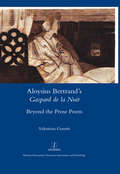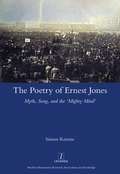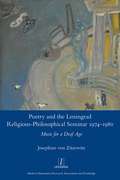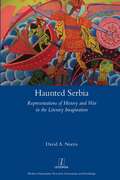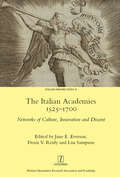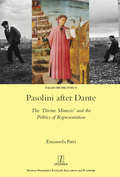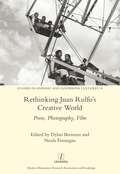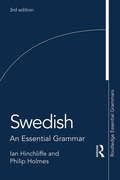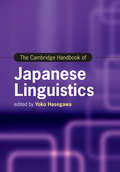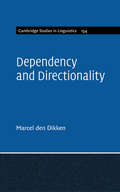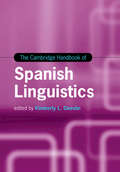- Table View
- List View
Space, Place and Autonomy in Language Learning (Routledge Research in Language Education)
by Garold Murray Terry LambThis book explores theories of space and place in relation to autonomy in language learning. Encompassing a wide range of linguistically and culturally diverse learning contexts, this edited collection brings together research papers from academics working in fourteen countries. In their studies, these researchers examine physical, virtual and metaphorical learning spaces from a wide range of theoretical and interdisciplinary perspectives (semiotic, ecological, complexity, human geography, linguistic landscapes, mediated discourse analysis, sociocultural, constructivist and social constructivist) and methodological approaches. The book traces its origins to the first-ever symposium on space, place and autonomy, which was held at the International Association of Applied Linguistics (AILA) 2014 World Congress in Brisbane. The final chapter, which presents a thematic analysis of the papers in this volume, discusses the implications for theory development, further enquiry, and pedagogical practice.
Corrective Feedback in Second Language Teaching and Learning: Research, Theory, Applications, Implications (ESL & Applied Linguistics Professional Series #66)
by Hossein Nassaji Eva KartchavaBringing together current research, analysis, and discussion of the role of corrective feedback in second language teaching and learning, this volume bridges the gap between research and pedagogy by identifying principles of effective feedback strategies and how to use them successfully in classroom instruction. By synthesizing recent works on a range of related themes and topics in this area and integrating them into a single volume, it provides a valuable resource for researchers, graduate students, teachers, and teacher educators in various contexts who seek to enhance their skills and to further their understanding in this key area of second language education.
Introducción a la traducción: inglés - español
by Antonio F Jiménez JiménezEste manual introduce al lector a la actividad de la traducción de inglés a español y viceversa, adoptando un punto de vista práctico y siguiendo los estándares profesionales actuales.? Introducción a la traducción examina una gran variedad de temas enfocados en resolver los problemas de traducción que se suelen encontrar en los textos, por ejemplo, en relación a los elementos culturales, los aspectos connotativos, la variación lingüística, la traducción subordinada y la traducción especializada. Para ello, se exploran detenidamente, y con multitud de ejemplos prácticos, las técnicas, estrategias y herramientas disponibles durante la actividad traductora. La página web que acompaña a este manual incluye además información lingüística contrastiva entre el inglés y el español para evitar problemas de transferencia negativa entre ambos idiomas.? Introducción a la traducción aumentará la competencia traductora de los lectores de una manera sistemática, coherente y contextualizada, ofreciendo oportunidades de práctica a través de un gran número de actividades y textos para traducir.? ? This manual introduces readers to the activity of Spanish-English/English-Spanish translation while adopting a practical perspective aligned with current professional standards.? Introducción a la traducción examines a wide variety of topics that focus on resolving common problems that tend to arise throughout the process of translating different kinds of texts. For example, this book explores translation issues with respect to cultural elements, connotative meaning, linguistic variations, constrained translation and specialized translation. It offers a multitude of practical examples and a thorough consideration of the techniques, strategies and tools available to translators. Among other resources, the companion website includes contrastive linguistic analysis of English and Spanish to help avoid negative transfer issues between both languages.? Introducción a la traducción will improve the reader’s competence as a translator in a systematic, coherent and contextualized way, providing abundant opportunities to practice translation skills through ample hands-on activities and a wide variety of texts to translate.
Pronunciaciones del español
by Donald N. Tuten Fernando Tejedo-Herrero Rajiv Rao H. Robyn ClarkePronunciaciones del español es una introducción accesible a la fonética y la fonología del español que destaca la diversidad de pronunciaciones empleadas en el mundo hispanohablante. Con explicaciones claras y gráficos detallados, este libro guía al estudiante en el aprendizaje de conceptos claves de fonética articulatoria y acústica. El libro presta especial atención a la variación sociolingüística, a partir de ejemplos que cubren pronunciaciones típicas de variedades estándares y de variedades generalmente consideradas no normativas. Una abundante selección de ejercicios y actividades permite al estudiante reforzar la comprensión de conceptos claves y practicar las pronunciaciones comentadas. Un glosario bilingüe (español-inglés), archivos de audio y recursos pedagógicos se encuentran disponibles en línea en www.routledge.com/9781138657540. El libro es idóneo para estudiantes que inician estudios al nivel avanzado de español y de lingüística hispánica y que buscan familiarizarse con las pronunciaciones de diferentes variedades de español. Pronunciaciones del español is an accessible introduction to the linguistic diversity of Spanish phonetics and phonology. With clear explanations and detailed illustrations, this book guides students through key concepts in articulatory and acoustic phonetics. Particular attention is paid throughout to sociolinguistic variation, with examples covering pronunciations typical of standard varieties as well as varieties generally considered to be non-normative. A rich array of exercises and activities allow students to reinforce understanding of key concepts and practice the pronunciations as described. A bilingual glossary, accompanying audio files and teaching resources are available online at www.routledge.com/9781138657540. This book is ideal for advanced students of Spanish and Hispanic Linguistics, looking to develop familiarity with the pronunciation of different varieties of Spanish.
Dutch: A Complete Language Course (Routledge Comprehensive Grammars)
by Bruce DonaldsonDutch: A Comprehensive Grammar is a complete reference to modern Dutch grammar. The volume is organized to promote a thorough understanding, and offers a stimulating analysis of the complexities of the language, while providing clear explanations. Throughout, the emphasis is on Dutch as used by present-day native-speakers. An extensive index and numbered paragraphs provide readers with easy access to the information they require. Concentrating on the real patterns of use in Dutch through accessible descriptions of the language, Dutch: A Comprehensive Grammar is an essential reference source for the learner of Dutch.
A Frequency Dictionary of German: Core Vocabulary for Learners (Routledge Frequency Dictionaries)
by Erwin Tschirner Jupp MöhringThis completely updated edition of A Frequency Dictionary of German contains the 5,000 most commonly used words of German today, occurring in a 20 million word corpus (compared to a 4.2 million corpus in the first edition). The basis of the frequency list is a significantly extended version of the Herder/BYU Corpus of Contemporary German. The Dictionary contains spoken and written German, and represents different genres, text types, registers, styles, and also regional varieties. The corpus is designed to represent the current German language as it is used in real world. Useful as a reference for students and course designers alike, A Frequency Dictionary of German is an important new resource.
Family Language Policies in a Multilingual World: Opportunities, Challenges, and Consequences (ESL & Applied Linguistics Professional Series)
by John Macalister Seyed Hadi MirvahediThrough case studies from around the world, this book illustrates the opportunities and challenges facing families negotiating the issues of language maintenance and language learning in the home. Every family living in a bi/multilingual environment faces the question of what language(s) to speak with their children and must make a decision, consciously or otherwise, about these issues. Exploring links between language policy in the home and wider society in a range of diverse settings, the contributors utilize various research tools, including interviews, questionnaires, observations, and archival document analysis, to explore linguistic ideologies and practices of family members in the home, illuminating how these are shaped by macro-level societal processes.
The Routledge Course in Korean Translation
by Jieun KiaerThe Routledge Course in Korean Translation brings together for the first time materials dedicated to the theory and practice of translation to and from Korean. This advanced course in Korean translation discusses cross-linguistic and cross-cultural issues that arise in the course of Korean-English and English-Korean translation and offers useful tools for dealing with the problems that arise in the actual practice of translation. Equipped with examples from a range of genres, this book provides a foundational understanding in translation theory that is necessary in Korean translation. The Routledge Course in Korean Translation is essential reading for students of Korean at both undergraduate and postgraduate levels interested in translation, as well as for students and researchers with knowledge of Korean who are interested in linguistics, and cultural and comunication studies.
Critical Literacy with Adolescent English Language Learners: Exploring Policy and Practice in Global Contexts (Routledge Research in Language Education)
by Jennifer AlfordThis book examines critical literacy within language and literacy learning, with a particular focus on English as an Additional Language learners in schools who traditionally are not given the same exposure to critical literacy as native-English speakers. An important and innovative addition to extant literature, this book explains how English language teachers understand critical literacy and enact it in classrooms with adolescent English language learners from highly diverse language backgrounds. This book brings together the study of two intersecting phenomena: how critical literacy is constructed in English language education policy for adolescent English language learners internationally and how critical literacy is understood and enacted by teachers amid the so-called ‘literacy crisis’ in neoliberal eduscapes. The work traces the ways critical literacy has been represented in English language education policy for adolescents in five contexts: Australia, England, Sweden, Canada and the United States. Drawing on case study research, it provides a comparative analysis of how policy in these countries constructs critical literacy, and how this then positions critical engagement as a focus for teachers of English language learners. Empirically based and accessibly written, this timely book will be of interest to a wide range of academics in the fields of adolescent literacy education, English language learning and teaching, education policy analysis, and critical discourse studies. It will also appeal to teachers, post-graduate students and language education policy makers.
New Perspectives on Intercultural Language Research and Teaching: Exploring Learners’ Understandings of Texts from Other Cultures (Routledge Research in Education)
by Michael Byram Melina PortoIllustrated by an empirical study of English as a Foreign Language reading in Argentina, this book argues for a different approach to the theoretical rationales and methodological designs typically used to investigate cultural understanding in reading, in particular foreign language reading. It presents an alternative approach which is more authentic in its methods, more educational in its purposes, and more supportive of international understanding as an aim of language teaching in general and English language teaching in particular.
A Frequency Dictionary of Korean: Core Vocabulary for Learners (Routledge Frequency Dictionaries)
by Sun-Hee Lee Seok Bae Jang Sang Kyu SeoA Frequency Dictionary of Korean is an invaluable tool for all learners of Korean, providing a list of the 5000 most frequently used words in the language. Based on the Sejong National Corpora, the largest written and spoken corpora in Korean comprised of 10 million words collected from different genres, the Dictionary provides the user with detailed information for each of the entries, including illustrative examples and English translations. The Dictionary provides a rich resource for language teaching and curriculum design, while a separate CD version provides the full text in a tab-delimited format ideally suited for use by corpus and computational linguists. With entries arranged both by frequency and alphabetically, A Frequency Dictionary of Korean enables students of all levels to get the most out of their study of vocabulary in an engaging and efficient way.
Children and Yiddish Literature From Early Modernity to Post-Modernity: From Early Modernity To Post-modernity (Legenda Ser.)
by Gennady Estraikh Kerstin Hoge Krutikov MikhailChildren have occupied a prominent place in Yiddish literature since early modern times, but children’s literature as a genre has its beginnings in the early 20th century. Its emergence reflected the desire of Jewish intellectuals to introduce modern forms of education, and promote ideological agendas, both in Eastern Europe and in immigrant communities elsewhere. Before the Second World War, a number of publishing houses and periodicals in Europe and the Americas specialized in stories, novels and poems for various age groups. Prominent authors such as Yankev Glatshteyn, Der Nister, Joseph Opatoshu, Leyb Kvitko, made original contributions to the genre, while artists, such as Marc Chagall, El Lissitzky and Yisakhar Ber Rybak, also took an active part. In the Soviet Union, meanwhile, children’s literature provided an opportunity to escape strong ideological pressure. Yiddish children’s literature is still being produced today, both for secular and strongly Orthodox communities. This volume is a pioneering collective study not only of children’s literature but of the role played by children in literature.
Aloysius Bertrand’s Gaspard de la Nuit Beyond the Prose Poem: Aloysius Bertrand’s Gaspard de la Nuit Beyond the Prose Poem
by Valentina GosettiAloysius Bertrand’s Gaspard de la Nuit (1842) is a familiar title to music lovers, thanks to Ravel’s piano work of the same name, and to specialists of French literature, especially those interested in Baudelaire’s prose poetry. Yet until very recently the collection and its author have generally been viewed almost exclusively through the prism of their pioneering role in the development of the prose poem. By placing Bertrand back in his original context, adopting a comparative approach and engaging with recent critical work on the collection, Valentina Gosetti proposes a substantial reassessment of Gaspard de la Nuit and promotes a new understanding of Bertrand in his own terms, rather than those of his successors. Through his playful and ironic reinterpretation of Romantic clichés, and his overt defiance of the boundaries of poetry and beauty, Bertrand emerges as a fascinating figure in his own right. This book is one of the first full-length studies of Bertrand’s work, and it will be of particular interest to specialists of the nineteenth century and of provincial literature, and to students of nineteenth-century poetry or the fantastic.
The Poetry of Ernest Jones Myth, Song, and the ‘Mighty Mind’: Myth, Song, And The 'mighty Mind (Legenda Ser.)
by Simon RennieAs the last leader of the Chartist movement, Ernest Charles Jones (1819-69) is a significant historical figure, but he is just as well-known for his political verse. His prison-composed epic The New World lays claim to being the first poetic exploration of Marxist historical materialism, and his caustic short lyric ‘The Song of the Low’ appears in most modern anthologies of Victorian poetry. Despite the prominence of Jones’s verse in Labour history circles, and several major inclusions in critical discussions of working-class Victorian literature, this volume represents the first full-length study of his poetry. Through close analysis and careful contextualization, this work traces Jones’s poetic development from his early German and British Romantic influences through his radicalization, imprisonment, and years of leadership. The poetry of this complex and controversial figure is here fully mapped for the first time.
Poetry and the Leningrad Religious-Philosophical Seminar 1974-1980: Music for a Deaf Age (Legenda Ser.)
by Josephine von ZitzewitzThe Religious-Philosophical Seminar, meeting in Leningrad between 1974-1980, was an underground study group where young intellectuals staged debates, read poetry and circulated their own typewritten journal, called ‘37’. The group and its journal offered a platform to poets who subsequently entered the canon of Russian verse, such as Viktor Krivulin (1944-2001) and Elena Shvarts (1948-2010). Josephine von Zitzewitz’s new study focuses on the Seminar’s identification of culture and spirituality, which allowed Leningrad’s unofficial culture to tap into the spirit of Russian modernism, as can be seen in ‘37’. This book is thus a study of a major current in twentieth-century Russian poetry, and an enquiry into the intersection between literary and spiritual concerns. But it also presents case studies of five poets from a special generation: not only Krivulin and Shvarts, but also Sergei Stratanovskii (1944-), Oleg Okhapkin (1944-2008) and Aleksandr Mironov (1948-2010).
Haunted Serbia: Representations of History and War in the Literary Imagination (Legenda)
by David NorrisHaunting is what happens when the past is disturbed and the victims of previous violence, who are thought to be buried and forgotten, are brought back to the present and made to live again. Serbian fiction writers of the 1980s exhume the ghosts of the past, re-remembering the cruelty of the twentieth century, reinterpreting the heroic role of the Partisans and the extraordinary measures taken to defend Yugoslavia’s recently won independence and socialist revolution. Their uncanny and ghostly imagery challenges the assumptions of the master discourse promoted by the country’s orthodox communist authorities and questions the historical roots of social and cultural identities. The instability of this period of transition is deepened during the wars of the 1990s, when authors turn from the memory of past violence to face the ferocious brutality of new conflicts. The haunting evocations in their work continue to articulate fresh uncertainties as the trappings of modern civilization are stripped away and replaced by the destructive logic of civil war. The past returns once more with renewed energy in the struggle to make sense of a vastly changed world.
The Italian Academies 1525-1700: Networks of Culture, Innovation and Dissent (Legenda)
by Jane E. Everson Denis V Reidy Lisa SampsonThe intellectual societies known as Academies played a vital role in the development of culture, and scholarly debate throughout Italy between 1525-1700. They were fundamental in establishing the intellectual networks later defined as the ‘République des Lettres’, and in the dissemination of ideas in early modern Europe, through print, manuscript, oral debate and performance. This volume surveys the social and cultural role of Academies, challenging received ideas and incorporating recent archival findings on individuals, networks and texts. Ranging over Academies in both major and smaller or peripheral centres, these collected studies explore the interrelationships of Academies with other cultural forums. Individual essays examine the fluid nature of academies and their changing relationships to the political authorities; their role in the promotion of literature, the visual arts and theatre; and the diverse membership recorded for many academies, which included scientists, writers, printers, artists, political and religious thinkers, and, unusually, a number of talented women. Contributions by established international scholars together with studies by younger scholars active in this developing field of research map out new perspectives on the dynamic place of the Academies in early modern Italy. The publication results from the research collaboration ‘The Italian Academies 1525-1700: the first intellectual networks of early modern Europe’ funded by the Arts and Humanities Research Council and is edited by the senior investigators.
Pasolini after Dante: The 'Divine Mimesis' and the Politics of Representation (Legenda)
by Emanuela PattiWhat role did Dante play in the work of Pier Paolo Pasolini (1922-1975)? His unfinished and fragmented imitation of the Comedia, La Divina Mimesis, is only one outward sign of what was a sustained dialogue with Dante on representation begun in the early 1950s. During this period, the philologists Gianfranco Contini (1912-1990) and Erich Auerbach (1892-1957) played a crucial role in Pasolini’s re-thinking of ‘represented reality’, suggesting Dante as the best literary, authorial and political model for a generation of postwar Italian writers. This emerged first as ‘Dantean realism’ in Pasolini’s prose and poetry, after Contini’s interpretation of Dante and of his plurilingualism, and then as ‘figural realism’ in his cinema, after Auerbach’s concepts of Dante’s figura and ‘mingling of styles’. Following the evolution of Pasolini’s mimetic ideal from these formative influences through to La Divina Mimesis, Emanuela Patti explores Pasolini’s politics of representation in relation to the ‘national-popular’, the ‘questione della lingua’ and the Italian post-war debates on neorealism, while also providing a new interpretation of some of his major literary and cinematic works.
Rethinking Juan Rulfo's Creative World: Prose, Photography, Film (Legenda)
by Nuala Finnegan Dylan BrennanThough primarily known for his haunting, enigmatic novel Pedro Páramo and the unrelenting depictions of the failures of post-revolutionary Mexico in his short story collection, El Llano en llamas, Juan Rulfo also worked as scriptwriter on various collaborative film projects and his powerful interventions in the area of documentary photography ensure that he continues to inspire interest worldwide. Bringing together some of the most significant names in Rulfian scholarship, this anthology engages with the complexity and diversity of Rulfo’s cultural production. The essays in the collection bring the Rulfian texts into dialogues with other cultural traditions and techniques including the Japanese Noh or "mask" plays and modernist experimentation in the Irish language. They also deploy diverse theoretical frameworks that range from Roland Barthes’ work on studium and punctum in photography to Henri Lefebvre’s ideas on space and spatiality and the postmodern insights of Jean Baudrillard on the nature of the simulacrum and the hyperreal. In this way, innovative approaches are brought to bear on the Rulfian texts as a way of illuminating the rich tensions and anxieties they evoke about Mexico, about history, about art and about the human condition.
Swedish: An Essential Grammar (Routledge Essential Grammars)
by Ian Hinchliffe Philip HolmesThis fully revised third edition of Swedish: An Essential Grammar incorporates changes proposed to Swedish grammar by Svenska Akademiens grammatik. Examples have been fully updated and the bibliography has been expanded. Swedish: An Essential Grammar provides a fresh and accessible description of the language. Explanations are free of jargon and emphasis has been placed on areas of Swedish that pose a particular challenge for English-speaking learners. The book offers: • a clear, accessible format; • authentic examples of language use, taken from a range of media; • clear, jargon-free explanations of grammar. Suitable for independent study or for class-based tuition, Swedish: An Essential Grammar continues to be an invaluable source to all learners looking to improve their knowledge of Swedish grammar.
The Cambridge Handbook of Japanese Linguistics (Cambridge Handbooks In Language And Linguistics)
by Yoko Hasegawa<P>The linguistic study of Japanese, with its rich syntactic and phonological structure, complex writing system, and diverse sociohistorical context, is a rapidly growing research area. This book, designed to serve as a concise reference for researchers interested in the Japanese language and in typological studies of language in general, explores diverse characteristics of Japanese that are particularly intriguing when compared with English and other European languages. It pays equal attention to the theoretical aspects and empirical phenomena from theory-neutral perspectives, and presents necessary theoretical terms in clear and easy language. <P>It consists of five thematic parts including sound system and lexicon, grammatical foundation and constructions, and pragmatics/sociolinguistics topics, with chapters that survey critical discussions arising in Japanese linguistics. The Cambridge Handbook of Japanese Linguistics will be welcomed by general linguists, and students and scholars working in linguistic typology, Japanese language, Japanese linguistics and Asian Studies.
Cambridge Studies in Linguistics: Dependency and Directionality (Cambridge Studies In Linguistics #154)
by Den Dikken MarcelThe direction in which the structure of sentences and filler-gap dependencies are built is a topic of fundamental importance to linguistic theory and its applications. This book develops an integrated understanding of structure building, movement and locality embedded in a syntactic theory that argues for a 'top down' approach, presenting an explicit counterweight to the bottom-up derivations pervading the Chomskian mainstream. It combines a compact and comprehensive historical perspective on structure building, the cycle, and movement, with detailed discussions of island effects, the typology of long-distance filler-gap dependencies, and the special problems posed by the subject in clausal syntax. Providing introductions to the main issues, reviewing extant arguments for bottom-up and top-down approaches, and presenting several case studies in its development of a new theory, this book should be of interest to all students and scholars of language interested in syntactic structures and the dependencies inside them.
The Cambridge Handbook of Spanish Linguistics (Cambridge Handbooks in Language and Linguistics)
by Kimberly L. GeeslinA state-of-the-art, in-depth survey of the topics, approaches and theories in Spanish linguistics today. The language is researched from a number of different perspectives. This Handbook surveys the major advances and findings, with a special focus on recent accomplishments in the field. It provides an accurate and complete overview of research, as well as facilitating future directions. It encourages the reader to make connections between chapters and units, and promotes cross-theoretical dialogue. The contributions are by a wide range of specialists, writing on topics including corpus linguistics, phonology and phonetics, morphosyntax, pragmatics, the role of the speaker and speech context, language acquisition and grammaticalization. This is a must-have volume for researchers looking to contextualize their own research and for students seeking a one-stop resource on Spanish linguistics.
Early and Late Latin
by James Adams Nigel Vincent Valerie KnightThis book addresses the question of whether there are continuities in Latin spanning the period from the early Republic through to the Romance languages. It is often maintained that various usages admitted by early comedy were rejected later by the literary language but continued in speech, to resurface centuries later in the written record (and in Romance). Are certain similarities between early and late Latin all that they seem, or might they be superficial, reflecting different phenomena at different periods? Most of the chapters, on numerous syntactic and other topics and using different methodologies, have a long chronological range. All attempt to identify patterns of change that might undermine any theory of submerged continuity. The patterns found are summarised in a concluding chapter. The volume addresses classicists with an interest in any of the different periods of Latin, and Romance linguists.
The Syntactic Structures of Korean
by Jong-Bok KimCovering both core and peripheral phenomena, The Syntactic Structures of Korean is a concrete and precise grammar of the language. Based on the framework of Sign-based Construction Grammar, it provides a grammar of Korean which is computationally implementable and cognitively viable. Remarkably broad, yet in-depth, it is an outstanding analysis of Korean syntax and semantics which will be welcomed by those working in linguistics and the Korean language.
